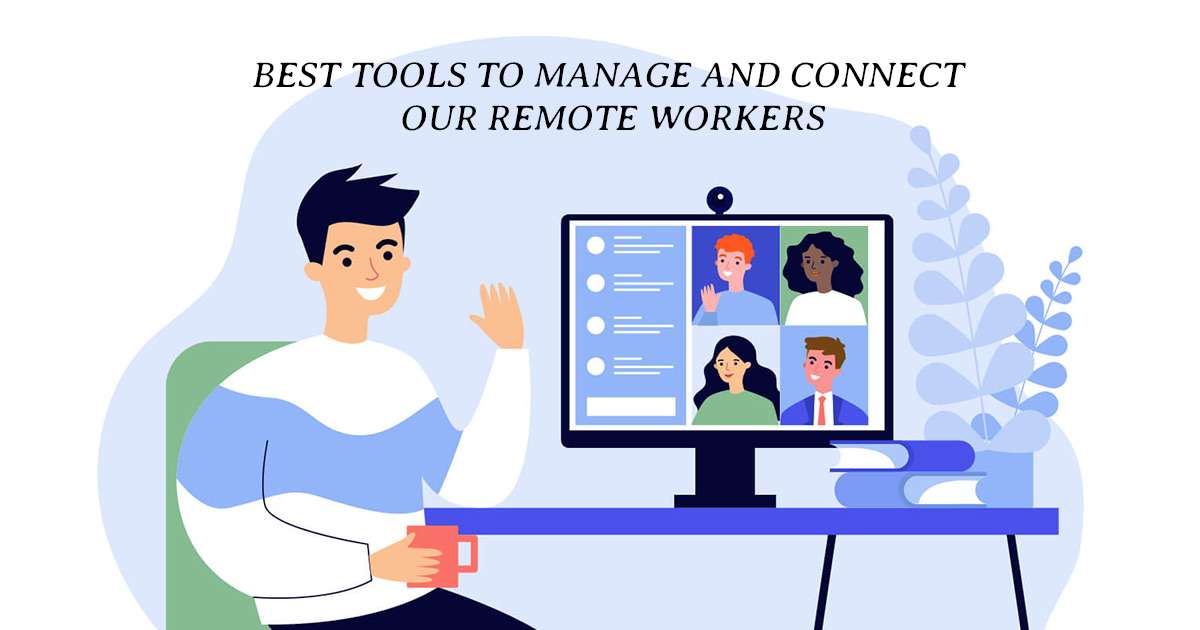15 Best Tools to Manage and Connect Your Remote Workers

Remote work systems play a crucial role in enabling organizations to embrace flexibility and productivity. These systems encompass a range of tools and platforms designed to facilitate seamless communication, efficient collaboration, and effective task management for remote teams.
How Can You Use Remote Tools to Manage Teams?
Systems for remote work enable team leaders and managers to properly supervise and coordinate scattered teams. Using these instruments helps managers keep open lines of contact among team members, allocate work, and track project development. This guarantees that, independent of geographical distances, team members remain in line with corporate objectives and deadlines are met effectively.
The Top Tools for Your Remote Workers
When it comes to equipping remote teams with the right tools, the choices can be overwhelming. Here’s a detailed look at some of the most effective tools available today:
ClickUp
ClickUp is a versatile project management platform that offers a comprehensive suite of features designed to streamline workflows and enhance team productivity. It allows teams to create tasks, set priorities, allocate resources, and track progress in a centralized dashboard. ClickUp’s customizable interface accommodates various project management methodologies, making it suitable for teams of all sizes and industries.
Asana
Asana simplifies team collaboration by providing a user-friendly interface for organizing tasks, projects, and deadlines. Teams can create project boards, assign tasks with due dates, and visualize workflow stages using Asana’s Kanban-style boards. The platform also integrates seamlessly with other productivity tools, such as Slack and Google Workspace, to streamline communication and enhance productivity.
Trello
Trello’s visual approach to task management makes it a popular choice among remote teams. Using Trello’s Kanban boards, teams can create task cards, move them through customizable stages (e.g., to-do, in progress, completed), and collaborate in real-time. Its simplicity and flexibility make Trello ideal for agile project management and team coordination across different time zones.
Notion
Notion combines note-taking, project management, and knowledge sharing into a single platform, making it a versatile tool for remote teams. Teams can create databases, manage tasks, draft documents, and collaborate on projects in a unified workspace. Notion’s customizable templates and database functionalities enable teams to tailor workflows according to their specific needs, whether for product development, content creation, or team documentation.
Timeproof
Timeproof is a time tracking and productivity tool designed to help remote workers manage their time effectively. It allows users to log hours spent on tasks, track project progress, and generate detailed reports for better time management and project accountability. Timeproof’s integration with project management tools like Asana and Trello ensures that time tracking seamlessly integrates into existing workflows, enabling teams to optimize productivity and meet deadlines consistently.
Hubstaff
Hubstaff offers time tracking, employee monitoring, and productivity management features tailored for remote teams. It allows managers to track time spent on tasks, monitor productivity levels, and capture screenshots to ensure accountability and efficiency. Hubstaff’s GPS tracking and geofencing capabilities enable organizations with field-based teams to manage remote workforces effectively, ensuring compliance with work hours and project deadlines.
Dropbox
Dropbox provides secure cloud storage and file sharing solutions that facilitate seamless collaboration among remote teams. It allows users to store, access, and share files securely from any device, ensuring that team members have real-time access to the latest documents and resources. Dropbox’s integration with productivity tools like Microsoft Office and Google Workspace enhances workflow efficiency by enabling direct editing and collaboration on shared documents.
Google Drive
Google Drive offers cloud storage and file synchronization services that enable remote teams to store, share, and collaborate on documents, spreadsheets, and presentations in real-time. Its robust security features, such as file encryption and access controls, ensure data privacy and compliance with industry regulations. Google Drive’s integration with Google Workspace enhances team collaboration by allowing seamless editing, commenting, and version control of shared files.
Zoom
Zoom has emerged as a leading video conferencing platform, facilitating virtual meetings, webinars, and online collaborations for remote teams worldwide. Its high-definition video and audio quality, along with screen sharing and recording capabilities, enable effective communication and engagement during remote meetings. Zoom’s scalability and compatibility with various devices ensure seamless connectivity and collaboration, making it a preferred choice for remote teams seeking reliable communication solutions.
Google Meet
Google Meet provides secure and scalable video conferencing solutions designed for remote teams within Google Workspace. It offers features such as real-time captioning, screen sharing, and integration with Google Calendar for scheduling meetings. Google Meet’s robust security measures, including encryption and privacy controls, ensure secure online meetings and protect sensitive information shared among team members. Its simplicity and accessibility make Google Meet an essential tool for remote teams looking to enhance collaboration and communication.
Slack
Slack is a messaging platform that centralizes team communication through channels, direct messaging, and integrations with third-party tools. It allows teams to organize conversations by projects, topics, or departments, ensuring relevant information is easily accessible to team members. Slack’s file sharing, video calling, and app integrations enhance productivity by streamlining communication and collaboration across remote teams. Its searchable message archives and notification settings enable efficient information retrieval and real-time updates, making Slack indispensable for remote teams managing multiple projects and workflows.
Hangouts
Google Hangouts offers instant messaging, voice, and video calling capabilities that facilitate real-time communication among remote teams. It integrates seamlessly with Google Workspace, allowing users to initiate conversations, share files, and conduct virtual meetings directly from their Gmail accounts. Google Hangouts’ simplicity and accessibility make it an ideal communication tool for remote teams seeking quick and efficient ways to connect and collaborate, regardless of geographical distances.
Canva
Canva is a graphic design platform that simplifies the creation of visuals for presentations, marketing materials, and social media posts. It offers a user-friendly interface with drag-and-drop functionality, customizable templates, and a vast library of design elements. Canva’s collaboration features enable remote teams to create, edit, and share designs in real-time, fostering creativity and brand consistency across projects. Its integration with cloud storage and social media platforms enhances workflow efficiency by allowing seamless publishing and sharing of visual content.
Airtable
Airtable combines the flexibility of a spreadsheet with the power of a database, making it a versatile tool for organizing and managing projects, tasks, and workflows. It allows teams to create custom databases, track project milestones, and collaborate on data-driven tasks in a collaborative workspace. Airtable’s integration with popular apps and services, such as Slack and Zapier, enhances workflow automation and data synchronization, enabling remote teams to streamline processes and improve productivity.
Empuls
Empuls is an employee engagement platform that enhances communication, recognition, and feedback among remote teams. It offers features such as pulse surveys, employee recognition awards, and social recognition walls to foster a positive work culture and boost team morale. Empuls’ analytics dashboard provides insights into employee engagement metrics, allowing organizations to identify trends, measure satisfaction levels, and take proactive steps to improve remote team dynamics. Its integration with collaboration tools and HR software ensures seamless implementation and alignment with organizational goals, making Empuls a valuable asset for remote teams seeking to enhance employee engagement and productivity.
How to Choose the Best Remote Worker Tools
Choosing the best remote worker tools requires careful consideration of your team’s specific needs and preferences. Here are some key factors to keep in mind:
- Assess Your Team’s Needs: Identify the primary challenges your team faces with remote work, such as communication barriers, project management complexities, or collaboration inefficiencies.
- Evaluate Features and Functionality: Look for tools that offer essential features like task management, file sharing, real-time collaboration, and integration capabilities with other software your team already uses.
- Consider User Experience: Opt for intuitive platforms that are easy to navigate and require minimal training for team members to adopt effectively.
- Review Security and Privacy: Prioritize tools with robust security measures, such as end-to-end encryption, data backup, and user authentication protocols, to protect sensitive information and comply with regulatory requirements.
- Seek Scalability and Compatibility: Choose tools that can scale with your team’s growth and are compatible with various devices and operating systems, ensuring seamless integration and accessibility for all team members.
- Take Advantage of Trials and Demos: Take advantage of free trials or demos offered by software providers to test the functionality, usability, and compatibility of remote work tools before making a commitment.
Improve Remote Team Productivity with the Best Tools
Empowering remote teams to successfully collaborate, communicate, and accomplish corporate objectives from any location depends on strong remote work tools and systems. Organizations may maximize workflow operations and create a healthy remote work environment by using top-rated solutions include ClickUp for project management, Slack for communication, and Zoom for virtual meetings. Discover these flexible technologies to improve the output of your remote staff, simplify processes, and effortlessly fit the changing needs of remote work.

